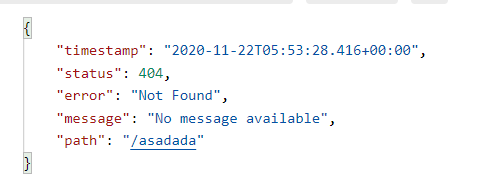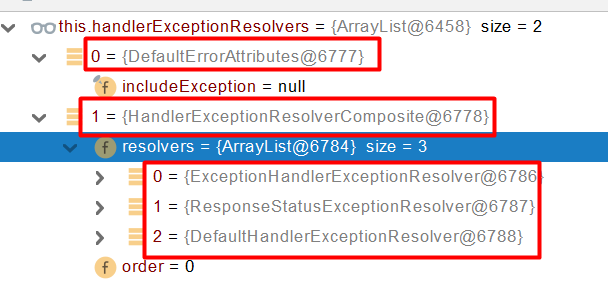一、默认异常处理机制
默认情况下,SpringBoot 提供 /error 请求,来处理所有异常的。
1.浏览器客户端,请求头里的属性是Accept:text/html。表明它想要一个html类型的文本数据。因此返回的错误视图以HTML格式呈现,也就是响应一个“ whitelabel”错误视图。

2.如果是其他客户端,请求头里的属性是Accept:/,默认响应一个json数据 。

二、异常处理流程
介绍异常处理流程前,要先认识HandlerExceptionResolver:处理器异常解析器接口,可以将异常映射到相应的统一错误界面,从而显示用户友好的界面(而不是给用户看到具体的错误信息)
public interface HandlerExceptionResolver {
//解析处理异常
ModelAndView resolveException(
HttpServletRequest request, HttpServletResponse response, Object handler, Exception ex);
}
在DispatcherServlet初始化时,已经把所有的HandlerExceptionResolver处理器异常解析器接口的实现类放到下面的集合里了
public class DispatcherServlet extends FrameworkServlet {
//异常解析器集合
private List<HandlerExceptionResolver> handlerExceptionResolvers;
}

从上图可以看出该集合里有DefaultErrorAttributes;还有HandlerExceptionResolverComposite处理器异常解析器组合,这里面包含了三个能真正处理异常的解析器,分别是ExceptionHandlerExceptionResolver、ResponseStatusExceptionResolver、DefaultHandlerExceptionResolver。下面会介绍他们几个分别用于处理什么异常。
阅读doDispatch()方法的源码可以看出,Spring MVC对整个doDispatch()方法用了嵌套的try-catch语句
- 内层的try-catch用于捕获
HandlerMapping进行映射查找HandlerExecutionChain以及HandlerAdapter执行具体Handler时的处理异常,并将异常传入到processDispatchResult(processedRequest, response, mappedHandler, mv, dispatchException)方法中。外层try-catch用于捕获渲染视图时的异常。 - 通过两层嵌套的
try-catch,SpringMVC就能够捕获到三大组件在处理用户请求时的异常,通过这样的方法能够很方便的实现统一的异常处理。
//处理分发结果
private void processDispatchResult(HttpServletRequest request, HttpServletResponse response,
HandlerExecutionChain mappedHandler, ModelAndView mv, Exception exception) throws Exception {
//判断HandlerMapping、HandlerAdapter处理时的异常是否为空
if (exception != null) {
Object handler = (mappedHandler != null ? mappedHandler.getHandler() : null);
//异常不为空,处理异常,进行异常视图的获取
mv = processHandlerException(request, response, handler, exception);
}
//只要存在mv就进行视图渲染
if (mv != null && !mv.wasCleared()) {
//不管视图是正常视图还是异常视图,均进入视图渲染流程
render(mv, request, response);
if (errorView) {
WebUtils.clearErrorRequestAttributes(request);
}
}
...略
...略
...略
}
从上面代码可以看出,当出现异常时会进入processHandlerException()方法进行异常视图的获取,处理完成后返回是ModelAndView对象。接下来不管视图是正常视图还是异常视图,只要ModelAndView不为空,均进入视图渲染流程。下面是如何进行进行异常视图的获取的代码。
//处理异常,进行异常视图的获取
protected ModelAndView processHandlerException(HttpServletRequest request, HttpServletResponse response,
Object handler, Exception ex) throws Exception {
// Check registered HandlerExceptionResolvers...
ModelAndView exMv = null;
//遍历所有的处理器异常解析器handlerExceptionResolvers,看谁能够处理当前异常
for (HandlerExceptionResolver handlerExceptionResolver : this.handlerExceptionResolvers) {
//解析当前异常
exMv = handlerExceptionResolver.resolveException(request, response, handler, ex);
if (exMv != null) {
//ModelAndView 不为空时,异常视图获取成功,跳出方法,进行异常视图渲染。
break;
}
}
...略
...略
...略
//所有处理器异常解析器都不能处理该异常,抛出异常
throw ex;
}
遍历所有的处理器异常解析器handlerExceptionResolvers,看谁能够处理当前异常

DefaultErrorAttributes先来处理异常。把异常信息保存到request域,并且返回null,并不能真正解析。HandlerExceptionResolverComposite会遍历它包含的三个异常解析器处理异常ExceptionHandlerExceptionResolver处理器异常解析器支持@ControllerAdvice+@ExceptionHandler处理全局异常ResponseStatusExceptionResolver处理器异常解析器支持@ResponseStatus+自定义异常DefaultHandlerExceptionResolver处理器异常解析器支持Spring底层的异常
当没有任何异常解析器能够处理异常,异常就会被抛出,最终Tomcat会发送 /error 请求,映射到底层的BasicErrorController进入默认的异常处理机制。
总结:
当发生异常时,会被catch。遍历所有的处理器异常解析器,看谁能够解析。如果你使用了@ControllerAdvice+@ExceptionHandler配置了全局异常处理,并指定了错误视图,那么该异常会被处理,然后进入视图渲染流程。如果该异常没能够被任何处理器异常解析器处理,就会抛出异常,由Tomcat发送/error请求,进入默认的异常处理机制,也就是开头说的,没有配置错误状态码页面,则返回默认我们常见的默认错误页。
访问的是不存在的路径,此时不会发生异常,经过处理器映射,处理器适配调用仍然返回的是空的ModelAndView,所以无法进行视图渲染。Tomcat仍会发送 /error请求,进入默认的异常处理机制。
三、默认的异常处理机制
要想弄懂错误处理原理,首先得看**ErrorMvcAutoConfiguration:这是错误处理的自动配置类**,给容器中添加了下面几个非常重要的组件。
ErrorPageCustomizerBasicErrorControllerDefaultErrorViewResolverDefaultErrorAttributes
首先我们看ErrorPageCustomizer 组件,此组件是一个静态内部类,位于ErrorMvcAutoConfiguration内。它实现了ErrorPageRegistrar接口,该接口提供了可以用来注册ErrorPage的方法。官方将ErrorPage 描述为:简单的服务器独立的错误页面抽象,大致相当于web.xml中传统的元素<error-page>。ErrorPage里包含了状态码、异常、和错误控制器映射路径(server.error.path=/error)。也就是说当发生了异常,而且所有的处理器异常解析器都处理不了该异常,Tomcat就会发送/error请求映射到BasicErrorController。
static class ErrorPageCustomizer implements ErrorPageRegistrar, Ordered {
//关于服务器的一些配置,如端口号,编码方式等。在这里主要关注server.error.path
private final ServerProperties properties;
private final DispatcherServletPath dispatcherServletPath;
protected ErrorPageCustomizer(ServerProperties properties, DispatcherServletPath dispatcherServletPath) {
this.properties = properties;
this.dispatcherServletPath = dispatcherServletPath;
}
//注册错误页面
@Override
public void registerErrorPages(ErrorPageRegistry errorPageRegistry) {
//ErrorPage里包含了状态码、异常、和错误控制器映射路径
ErrorPage errorPage = new ErrorPage(
//this.properties.getError().getPath()获取的就是server.error.path=/error(默认)
this.dispatcherServletPath.getRelativePath(this.properties.getError().getPath()));
//注册ErrorPage
errorPageRegistry.addErrorPages(errorPage);
}
}
====================DispatcherServletPath接口=================================
public interface DispatcherServletPath {
default String getRelativePath(String path) {
String prefix = getPrefix();
if (!path.startsWith("/")) {
path = "/" + path;
}
return prefix + path;
}
}
下面介绍的就是BasicErrorController。它里面有两个重要的方法,正好对象开头说的默认处理机制。方法一:如果是浏览器请求,则返回HTML响应数据text/html,方法二:如果是其他客户端请求,则返回JSON响应数据。
@Controller
//server.error.path 为空则用error.path, 再为空,再用/error
@RequestMapping("${server.error.path:${error.path:/error}}")
public class BasicErrorController extends AbstractErrorController {
//1、产生html类型的数据;浏览器客户端发送的请求来到这个方法处理
@RequestMapping(produces = MediaType.TEXT_HTML_VALUE)
public ModelAndView errorHtml(HttpServletRequest request, HttpServletResponse response) {
//状态码
HttpStatus status = getStatus(request);
//从DefaultErrorAttributes里获取可以在页面显示的数据
Map<String, Object> model = Collections
.unmodifiableMap(getErrorAttributes(request, getErrorAttributeOptions(request, MediaType.TEXT_HTML)));
response.setStatus(status.value());
//调用父类里的方法,寻找错误视图解析器,来解析错误视图
ModelAndView modelAndView = resolveErrorView(request, response, status, model);
//!!!如果没有配置具体的状态码错误页面或4xx,5xx这种视图,视图解析不成功,就会返回空的ModelAndView对象。此时就会构造一个默认的error错误视图,通过BeanNameViewResolver视图解析器,根据视图名(error)作为组件id去容器中找到View对象
return (modelAndView != null) ? modelAndView : new ModelAndView("error", model);
}
//2、产生json数据,其他客户端来到这个方法处理
@RequestMapping
public ResponseEntity<Map<String, Object>> error(HttpServletRequest request) {
HttpStatus status = getStatus(request);
if (status == HttpStatus.NO_CONTENT) {
return new ResponseEntity<>(status);
}
Map<String, Object> body = getErrorAttributes(request, getErrorAttributeOptions(request, MediaType.ALL));
return new ResponseEntity<>(body, status);
}
}
========================AbstractErrorController================================
protected ModelAndView resolveErrorView(HttpServletRequest request,HttpServletResponse response, HttpStatus status, Map<String, Object> model) {
for (ErrorViewResolver resolver : this.errorViewResolvers) {
//错误视图解析器获取错误视图,返回ModelAndView
ModelAndView modelAndView = resolver.resolveErrorView(request, status, model);
if (modelAndView != null) {
return modelAndView;
}
}
return null;
}
总结一下,BasicErrorController主要作用:
处理默认/error 路径的请求
调用DefaultErrorViewResolver进行错误视图解析,分为三种情况
1.模板引擎支持解析,就去 /templates/error/下寻找我们配置的 状态码错误页面,例如404.html 或4xx.html。
2.模板引擎找不到这个错误页面,就去静态资源文件夹【/resources/、/static/、/public/、/META-INF/resources/】下的error文件夹下寻找状态码错误页面。
3.静态资源文件夹下也找不到,则new ModelAndView("error", model)构造一个默认的错误视图【就是经常见到的 Whitelabel Error Page】。该默认的错误视图在ErrorMvcAutoConfiguration里已经注册到容器里了,并且它在容器中的id就是error。后面就会通过BeanNameViewResolver视图解析器,根据视图逻辑 error,作为组件id去容器中就可以找到默认的错误视图。
=========================ErrorMvcAutoConfiguration========================================
protected static class WhitelabelErrorViewConfiguration {
private final StaticView defaultErrorView = new StaticView();
//向容器种注册默认的错误视图,id为error
@Bean(name = "error")
@ConditionalOnMissingBean(name = "error")
public View defaultErrorView() {
return this.defaultErrorView;
}
}
//可以看到静态内部类StaticView,进行视图渲染的时候,构造了我们经常看到的默认错误页面Whitelabel Error Page。
private static class StaticView implements View {
@Override
public void render(Map<String, ?> model, HttpServletRequest request, HttpServletResponse response)
throws Exception {
if (response.isCommitted()) {
String message = getMessage(model);
logger.error(message);
return;
}
response.setContentType(TEXT_HTML_UTF8.toString());
StringBuilder builder = new StringBuilder();
Object timestamp = model.get("timestamp");
Object message = model.get("message");
Object trace = model.get("trace");
if (response.getContentType() == null) {
response.setContentType(getContentType());
}
builder.append("<html><body><h1>Whitelabel Error Page</h1>").append(
"<p>This application has no explicit mapping for /error, so you are seeing this as a fallback.</p>")
.append("<div id='created'>").append(timestamp).append("</div>")
.append("<div>There was an unexpected error (type=").append(htmlEscape(model.get("error")))
.append(", status=").append(htmlEscape(model.get("status"))).append(").</div>");
if (message != null) {
builder.append("<div>").append(htmlEscape(message)).append("</div>");
}
if (trace != null) {
builder.append("<div style='white-space:pre-wrap;'>").append(htmlEscape(trace)).append("</div>");
}
builder.append("</body></html>");
response.getWriter().append(builder.toString());
}
}
接下来就是介绍 DefaultErrorViewResolver,主要就是进行错误视图解析。如果发生错误,就会以HTTP的状态码 作为视图地址,找到真正的错误页面。但是注意,首先是精确查找具体的错误状态码页面,然后是按照4xx,5xx这种查找。
public class DefaultErrorViewResolver implements ErrorViewResolver, Ordered {
private static final Map<Series, String> SERIES_VIEWS;
static {
Map<Series, String> views = new EnumMap<>(Series.class);
views.put(Series.CLIENT_ERROR, "4xx");
views.put(Series.SERVER_ERROR, "5xx");
SERIES_VIEWS = Collections.unmodifiableMap(views);
}
//解析错误视图,要去的错误页面
@Override
public ModelAndView resolveErrorView(HttpServletRequest request, HttpStatus status, Map<String, Object> model) {
//先精确查找错误视图
ModelAndView modelAndView = resolve(String.valueOf(status.value()), model);
//精确查找不到,则查找4xx,5xx这种类型的错误页面
if (modelAndView == null && SERIES_VIEWS.containsKey(status.series())) {
modelAndView = resolve(SERIES_VIEWS.get(status.series()), model);
}
return modelAndView;
}
//真正解析 viewName是状态码
private ModelAndView resolve(String viewName, Map<String, Object> model) {
//!!!!默认SpringBoot可以去找到一个页面 error/404,注意定制错误页面要放在error文件夹下,如error/4xx.html
String errorViewName = "error/" + viewName;
//模板引擎可以解析这个页面地址就用模板引擎解析
TemplateAvailabilityProvider provider = this.templateAvailabilityProviders
.getProvider(errorViewName, this.applicationContext);
if (provider != null) {
//模板引擎可用的情况下返回到errorViewName指定的视图地址
return new ModelAndView(errorViewName, model);
}
//模板引擎不可用,就在静态资源文件夹下找errorViewName对应的页面 error/404.html
return resolveResource(errorViewName, model);
}
//模板引擎不可用,就去静态资源文件夹下寻找
private ModelAndView resolveResource(String viewName, Map<String, Object> model) {
//这里遍历的是"classpath:/META-INF/resources/","classpath:/resources/", "classpath:/static/", "classpath:/public/"
for (String location : this.resourceProperties.getStaticLocations()) {
try {
Resource resource = this.applicationContext.getResource(location);
resource = resource.createRelative(viewName + ".html");
if (resource.exists()) {
return new ModelAndView(new HtmlResourceView(resource), model);
}
}
catch (Exception ex) {
}
}
return null;
}
}
最后介绍DefaultErrorAttributes,里面存放了错误页面能够显示的数据。比如状态码、错误提示、异常消息等。
public class DefaultErrorAttributes implements ErrorAttributes, HandlerExceptionResolver, Ordered {
//帮我们在页面共享信息
@Override
public Map<String, Object> getErrorAttributes(RequestAttributes requestAttributes,
boolean includeStackTrace) {
Map<String, Object> errorAttributes = new LinkedHashMap<String, Object>();
errorAttributes.put("timestamp", new Date());
addStatus(errorAttributes, requestAttributes);
addErrorDetails(errorAttributes, requestAttributes, includeStackTrace);
addPath(errorAttributes, requestAttributes);
return errorAttributes;
}
}
总结:
- 当发生了异常,而且所有的处理器异常解析器都处理不了该异常,
ErrorPageCustomizer就会生效(定制错误的响应规则)。Tomcat就会发送/error请求,然后被HandlerMapping映射到BasicErrorController处理。 - 解析错误视图:前提是配置了4xx.html、5xx.html错误状态码页面,去哪个状态码错误页面就由
DefaultErrorViewResolver解析得到。如果没有配置错误状态码页面,就是默认的错误视图StaticView,它是位于ErrorMvcAutoConfiguration里的一个静态内部类,被自动注册到容器中。后面进行视图渲染的时候,就是StaticView里的render()方法构造了我们经常看到的默认错误页面【Whitelabel Error Page】。 - 提取数据:页面能够获取什么数据是由
DefaultErrorViewResolver设置的。
四、自定义异常处理
1、自定义异常处理页
有模板引擎的情况下
- 没有模板引擎(模板引擎找不到这个错误页面),静态资源文件夹下找。依然要将错误页面放在error文件夹下。
- error/状态码.html,就是将错误页面命名为
状态码.html放在模板引擎文件夹里面的 error文件夹下;我们可以使用4xx和5xx作为错误页面的文件名来匹配这种类型的所有错误,不过优先寻找精确的状态码.html。 - 以上都没有找到错误页面,就是默认来到SpringBoot默认的错误提示页面。
错误页面能获取的信息DefaultErrorAttributes:
- timestamp:时间戳
- status:状态码
- error:错误提示
- exception:异常对象
- message:异常消息
- errors:JSR303数据校验的错误都在这里
2、@ControllerAdvice+@ExceptionHandler处理全局异常
底层是由 ExceptionHandlerExceptionResolver处理器异常解析器支持的
3、@ResponseStatus+自定义异常
底层是由 ResponseStatusExceptionResolver处理器异常解析器支持的,但是它解析完成后,调用了 **response.sendError(statusCode, resolvedReason);**由tomcat发送的/error请求,进入默认异常处理机制。
Spring底层的异常
如 参数类型转换异常;由DefaultHandlerExceptionResolver 处理器异常解析器支持的,处理框架底层的异常。但是它解析完成后,调用了 response.sendError(HttpServletResponse.SC_BAD_REQUEST, ex.getMessage()); 由tomcat发送的/error请求,进入默认处理机制。
扩展:【可不看】
自定义处理器异常解析器、错误视图解析器:
实现 HandlerExceptionResolver接口自定义处理器异常解析器;可以作为默认的全局异常处理规则

实现ErrorViewResolver自定义错误视图解析器
到此这篇关于SpringBoot的异常处理流程是什么样的?的文章就介绍到这了,更多相关SpringBoot异常处理内容请搜索自学编程网以前的文章或继续浏览下面的相关文章希望大家以后多多支持自学编程网!

- 本文固定链接: https://zxbcw.cn/post/214695/
- 转载请注明:必须在正文中标注并保留原文链接
- QQ群: PHP高手阵营官方总群(344148542)
- QQ群: Yii2.0开发(304864863)
